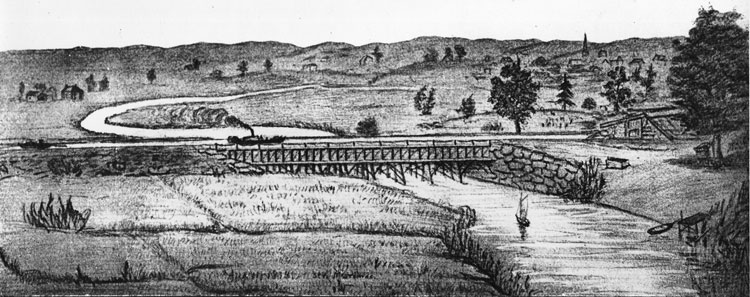
Middlesex Canal Association P.O. Box 333 Billerica, Massachusetts 01821
www.middlesexcanal.org

Middlesex Canal Association P.O. Box 333 Billerica, Massachusetts 01821
www.middlesexcanal.org
| Volume 62 No. 2 | February 2024 |
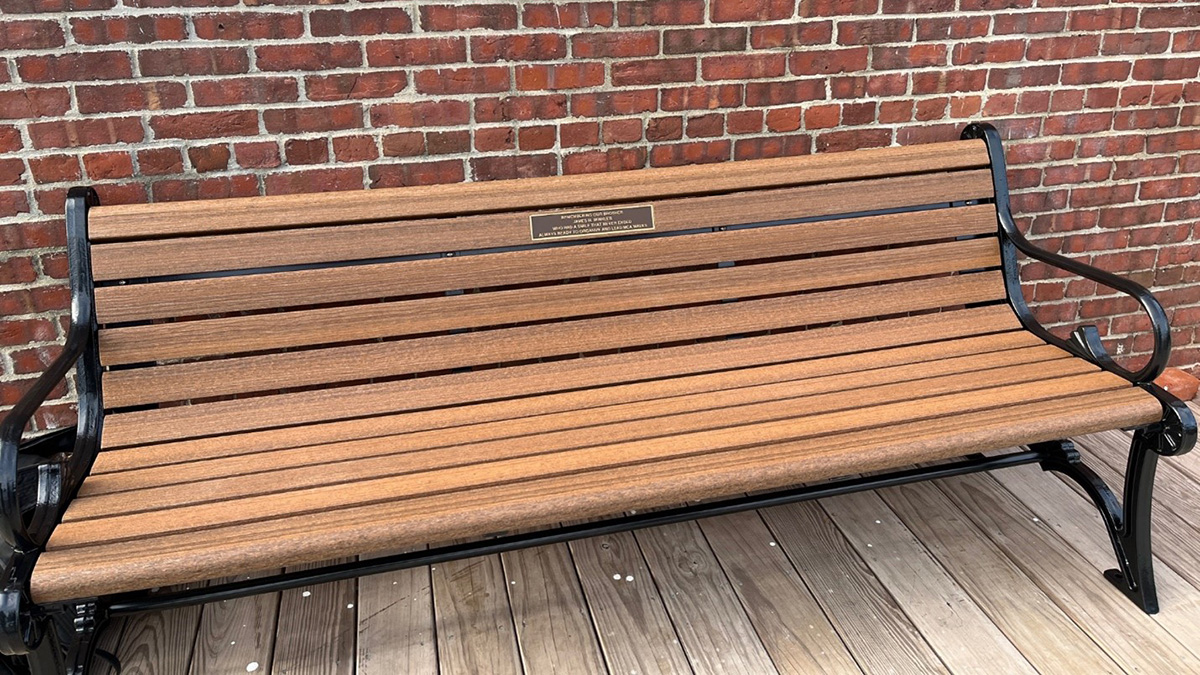
The Jim Winkler Memorial Bench installed on the deck of the future home of the MCA Museum at 2 Old Elm Street in North Billerica, MA.
Jim’s story is highlighted in this issue.
TABLE OF CONTENTS
MCA Sponsored Events and Directions to the MCA Museum and Visitors’ Center
President’s Message from J. Jeremiah Breen
Annual Appeal “Thank You” by Russ Silva
“The Quest for an Occupancy Permit: A Progress Report at 2 Old Elm Street” by Betty M. Bigwood
“A Brisk Fall Walk” by Neil P. Devins
Fall Meeting Minutes by J. Jeremiah Breen
“New Memorial Bench in Memory of James H. Winkler on Deck of New MCA Museum by Anne Winkler
“Meets and Passes” by Bill Gerber
“The Canal Corporation’s First Female Shareholder: Elizabeth Guild” by Brian JM Quinn
“Miss Fanny Searle to Mrs. Margaret Curzon” reprinted from the Oct 1971 Towpath Topics with Editors’ notes by Alec Ingraham
Editors’ Letter
Dear Readers,
Another winter meeting of the MCA is fast approaching and to announce its appearance is this new issue of Towpath Topics. The winter meeting is scheduled for February 18, 2024 in the Reardon Room.
After our dam issue, full of current events, we have stepped back into the past for this one. First is an entry by Bill Gerber called “Meets and Passes” possibly subtitled “Boat Etiquette.”! Next is an article by Brian JM Quinn, about the first female shareholder of the Middlesex Canal, Elizabeth Guild. The editors have submitted a corresponding entry, first published in a 1971 issue of Towpath Topics. The world of Elizabeth Guild and the one described by Fanny Searle about a canal ride fill out a picture of life in the early 19th Century for women.
On the business side of the issue is the President’s Message, a thank you from the Treasurer, Russ Silva, a new museum construction update by Betty Bigwood, and the usual dates and events. Lastly is an entry and photographs by Anne Winkler, daughter of Howard and Lenore, describing the importance of the New Memorial Bench to the Winkler Family. The decisions to create it, in the memory of their brother, Jim, were made by Anne and her brother, Mitchell.
Read and enjoy!
The Editors
MCA Sponsored Events – 2024 Schedule
Winter Meeting: 1:00pm, Sunday February 18, 2024
Douglas Chandler, a proprietor of the Middlesex Canal Association and a member of the State’s Middlesex Canal Commission, will talk about using the towpath of the historic Middlesex Canal as the connecting link for bike paths between the Minuteman at Bedford, the Bruce Freeman at Lowell, and north over the Rourke Bridge. Mr. Chandler’s talk will be in the Reardon Room, Middlesex Canal Museum-Visitor Center, at the Billerica Falls of the Concord River, 71 Faulkner Street, Billerica, MA 01862. The Visitor Center opens at noon. The Middlesex Canal Association will have a ten-minute meeting before the talk. If a storm requires change, a message will be on the museum phone, (978) 671-2740.
Spring Walk: 1:30pm, Sunday, March 17, 2024 – Winchester South to Medford
A four-mile round trip. Meet in the Sandy Beach parking lot, 4 Mystic Valley Parkway, Winchester, MA 01890.
Bike Tour South: 11:15am, Saturday, April 6, 2024
Meet at the Lowell train station. Leaders will be Dick Bauer and Bill Kuttner. The 11:15am time will change with the Lowell MBTA Lowell line schedule.
Annual Meeting: 1:00pm, Sunday, April 28, 2024
Speaker TBA
Meet in the Reardon Room of the museum, 71 Faulkner Street, Billerica, MA 01862.
22nd Fall Bike Tour: 9:00am, Saturday, October 5, 2024
Meet at the Middlesex Canal plaque right at the entrance to Sullivan Square T Station, 1 Cambridge Street, Charlestown, MA 02129. Leaders will be Dick Bauer and Bill Kuttner.
Fall Walk: 1:30pm, Sunday, October 13, 2024 – Billerica North to Chelmsford
Meet at Billerica Falls, 71 Faulkner Street, Billerica, MA 01862.
Fall Meeting: 1:00pm, Sunday, October 27, 2024
Speaker TBA
Note: Walks and Bicycle Tours: For more detailed information please access the MCA website at www.middlesexcanal.org about a week prior to the scheduled event.
The Visitors Center/Museum is open Saturday and Sunday, Noon – 4:00pm, except on a holiday.
The Board of Directors meets the 1st Wednesday of each month, 3:30-5:30pm, except July and August.
Check the MCA website for updated information during the COVID-19 pandemic.
Directions to Museum: 71 Faulkner Street in North Billerica, MA
By Car
From Rte. 128/95
Take Route 3 (Northwest Expressway) toward Nashua, to Exit 78 (formerly Exit 28) “Treble Cove Road, North Billerica, Carlisle”. At the end of the ramp, turn left onto Treble Cove Road toward North Billerica. At about ¾ mile, bear left at the fork. After another ¼ mile, at the traffic light, cross straight over Route 3A (Boston Road). Go about ¼ mile to a 3-way fork; take the middle road (Talbot Avenue) which will put St. Andrew’s Church on your left. Go ¼ mile to a stop sign and bear right onto Old Elm Street. Go about ¼ mile to the bridge over the Concord River, where Old Elm Street becomes Faulkner Street; the Museum is on your left and you can park across the street on your right, just beyond the bridge. Watch out crossing the street!
From I-495
Take Exit 91 (formerly Exit 37) North Billerica, then south roughly 2 plus miles to the stop sign at Mt. Pleasant Street, turn right, then bear right at the Y, go 700’ and turn left into the parking lot. The Museum is across the street (Faulkner Street). To get to the Visitor Center/Museum enter through the center door of the Faulkner Mill and proceed to the end of the hall.
By Train
The Lowell Commuter line runs between Lowell and Boston’s North Station. From the station side of the tracks at North Billerica, the Museum is a 3-minute walk down Station Street and Faulkner Street on the right side.
President’s Message, “The Billerica Falls Fishway”
by J. Breen
1. Straw Man.
The Board of Directors of the Association voted on March 2, 2016 to oppose removal of the dam built by the Middlesex Canal Company in 1828, which replaced the leaky dam the Company had built in 1798. The dam was built to store water used to operate the canal with surplus water used to power mills. The dam was built at the high point of the canal, 107’ above the Charles River at Boston and 26’ above the Merrimack, creating the summit pond at the high point of the 27-mile canal. Thoreau wrote in A Week on the Concord and Merrimac Rivers of the Middlesex Canal and the Billerica Falls.
The dam was built with a fishway and rock ramp at the right bank of the Concord River. The proponents of removing the dam and draining the summit pond considered a fish ladder as an alternative to removing the dam.
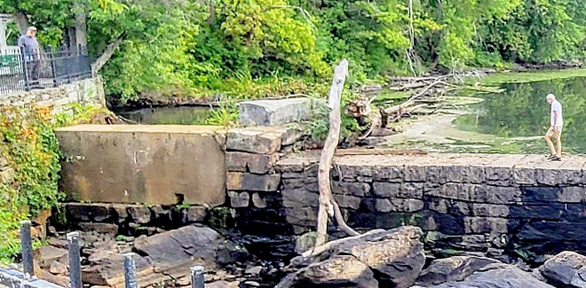
Entrance to 1828 fishway blocked by concrete.
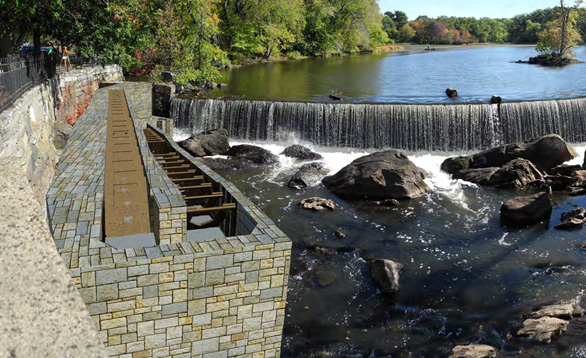
Artist rendering of fish ladder alternative. It is on the 1828 rock ramp to the fishway
in the dam which extends upriver. Diadromous Fish Feasibility Final Report, 2016.
The proponents of dam removal dismissed their massive fish ladder as an unfeasible alternative compared to dam removal.1 Yet the Mystic Lakes Dam was rebuilt with a fish ladder in 2012 with such a successful return of herring that the upriver Winchester and Horn Pond dams are being rebuilt with fish ladders.2
2. Section 106, National Historic Preservation Act of 1966
“A federal agency must conclude Section 106 review before making a decision to approve a project, or fund or issue a permit that may affect a historic property. Agencies should not make obligations or take other actions that would preclude consideration of the full range of alternatives to avoid or minimize harm to historic properties before Section 106 review is complete.” 3 [Emphasis added]
The US Fish and Wildlife Service has granted $800,000 to OARS, Inc., Concord MA, for removal of the dam before a Sec. 106 review has been concluded.4
3. Massachusetts Historical Commission.
To successfully complete Section 106 review, federal agencies must do the following: . . . reach agreement with the SHPO (and the ACHP in some cases) on such measures to resolve any adverse effects or, failing that, obtain advisory comments from the ACHP, which are sent to the head of the agency.5
Brona Simon, executive director of the Massachusetts Historical Commission, is the State Historic Preservation Officer (SHPO) appointed by the governor under Section 106 of the National Historic Preservation Act. The SHPO may not veto a project but may delay it.
An example of delay in the work of the SHPO is in the CommonWealth magazine article, “Historical Roadblock”.6
Notes:
1. Concord River Diadromous Fish Restoration: Feasibility Study: Final Report prepared by Gomez and Sullivan, Engineers, 2016. http://archives.lib.state.ma.us/handle/2452/626310 N. B., the appendices, A - I, are separate files.
2. The Amazing Return of Mystic Herring (arcgis.com)rmm Mystic River Watershed Association, December 5, 2023. http://tinyurl.com/MCA-MysticDam See also, President’s Message, “Dam Removal 2”, http://middlesexcanal.org/towpath/towpathtopicsOct2022.htm#president http://tinyurl.com/DamRemoval2
3. A Citizen’s Guide to Section 106 Review, page 12. achp.gov/sites/default/files/documents/2017-01/CitizenGuide.pdf
Advisory Council on Historic Preservation (ACHP) http://tinyurl.com/MCA-citizens2
4. Talbot Mills Dam Removal on the Concord River | U.S. Fish & Wildlife Service (fws.gov) http://tinyurl.com/MCA-OARS
5. A Citizen’s Guide to Section 106 Review, page 5, op. cit.
6. “Historical Roadblock”, Winter 2012 - CommonWealth Beacon , pp. 48-53. https://tinyurl.com/MCA-roadblock
Annual Appeal “Thank You”
from Russ Silva, Treasurer
The Middlesex Canal Association’s thanks go to the forty-three individuals who, as of Thursday, January 18th, have donated $4,720 to the 2023 Annual Appeal. This includes $1,385 to the Building Fund but only $150 to Endowment Fund. The rest will be applied to Current Expenses.
The number of donors is a little more than last year. Individual contributions vary from $10 to $750. The total amount given to the appeal was less than most of the last fifteen years. But once again, throughout the past year one of our largest contributors donated a significant amount to the 2 Old Elm Museum Building renovation project directly instead of through the Appeal. And in January there have been at least two other donations of $250 and $500 to the Building Fund that weren’t included in the Appeal total above. Thanks to those folks, too, for their generosity.
If anyone else wishes to send a contribution in any amount for the benefit of the Endowment Fund, the New Museum/Building Fund, or the “General” Fund for Current Expenses, please do, and thank you. There is no time limit. Last year we received contributions in June and August.
The Quest for an Occupancy Permit: A Progress Report at 2 Old Elm Street
by Betty Bigwood
Late in 2023 I received a call from Bill Cogley, our contractor, saying he planned to finish two major projects early in 2023 and then he planned to turn his attention to getting us into 2 Old Elm by mid-summer. We were pleased to hear this. He then proceeded to give us a list of requirements to get us underway. He planned to start in March after a month in Florida.
First, he finished the framing and then we called in Jusczak Electric to complete the Fire Alarm System. A special panel is required which could not freeze. The heat pump has not been installed yet. Cogley solved this problem by covering the panel with an insulated box which housed a light bulb – clever.
Changing from fossil fuel to Heat Pump has been a complicated design but we still think it was a correct decision. Johnson and Johnson Engineers and their subcontractors have been learning too, as we bring our building up to the new codes – but it has been tedious. We have relied heavily on Dick Hawes, Building Committee member, to supervise this phase. Cogley would like this to be completed by the time he returns in March so they can be comfortable to work inside.
The sprinkler system we chose with a dry phase in the attic and water in the first two floors should be underway any day now at a new cost of $75,800.
There are a few changes to make with the platform lift. You enter from the east side and exit from the west side on the second floor– this saves space and adds another 10 inches to the kitchen. The space we were planning for the utility room behind the proposed elevator will have a new function. Extra space is always handy.
We need to finish up the rough electrical and pumping requirements, put in dry wall and then complete these utilities.
Finally, we have the Order of Conditions from The Conservation Commission to complete. Fortunately, Conservation extended the Order to June of this year to finish plantings, weed removal, footbridge footings and asphalt contours around the car park. There is a lot to do to finally occupy the building.
A Brisk Fall Walk
by Neil P. Devins
It was a sunny but brisk day for the participants in our October 15 Fall Walk three months ago. The walk was from the Middlesex Canal Parkway in Woburn south to Winn Street in Woburn, with an optional extra hike from the Baldwin Mansion north to School Street and back. There were approximately 25 walkers, 20 of which were from the Cambridge and Oxford Alumni Society. Their leader had contacted me several months earlier.
We began with my describing the importance of the city of Woburn in the life of the MC, providing the Superintendent/Chief Engineer, Loammi Baldwin and reiterated J. Breen’s message that Woburn received tanbark from the canal. This was the beginnings of the leather business, leading to the presence of 22 shoe manufacturers in Woburn later in the 19th century. I briefly spoke about the first “resort” in the Boston area, Horn Pond.
We began our walk from the MC Parkway, staying on the relatively dry towpath the entire trip. Explained, as we walked southerly, that one could see the remnants of the embankment that was a spur off of the Boston and Lowell RR, which had traveled from North Woburn to Woburn center, with the depot being directly across from the Library on Pleasant St. Almost as soon as we began our journey, it was pointed out that there was Coolidge Road off and up on the berm side, which continued over the canal via a bridge to the continuation of a street that no longer exists. There were at least two wooden pilings which appeared to be the remains of the supports for the bridge rising straight out of the ground. This had been known as Parker’s bridge, named after Porter Parker, who ran a harness shop. When we reached Wyman St., right after it merges with Lowell Street, we were crossing Benjamin Edgell’s bridge, whose home overlooked the canal.
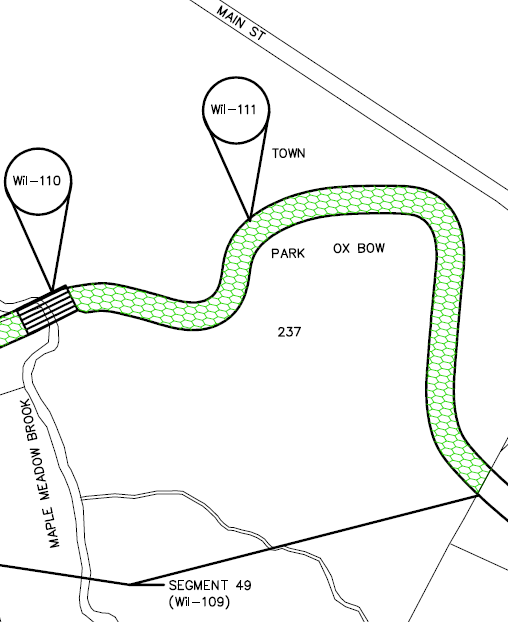
A map of the Wilmington Ox Bow on the Route of the Middlesex Canal
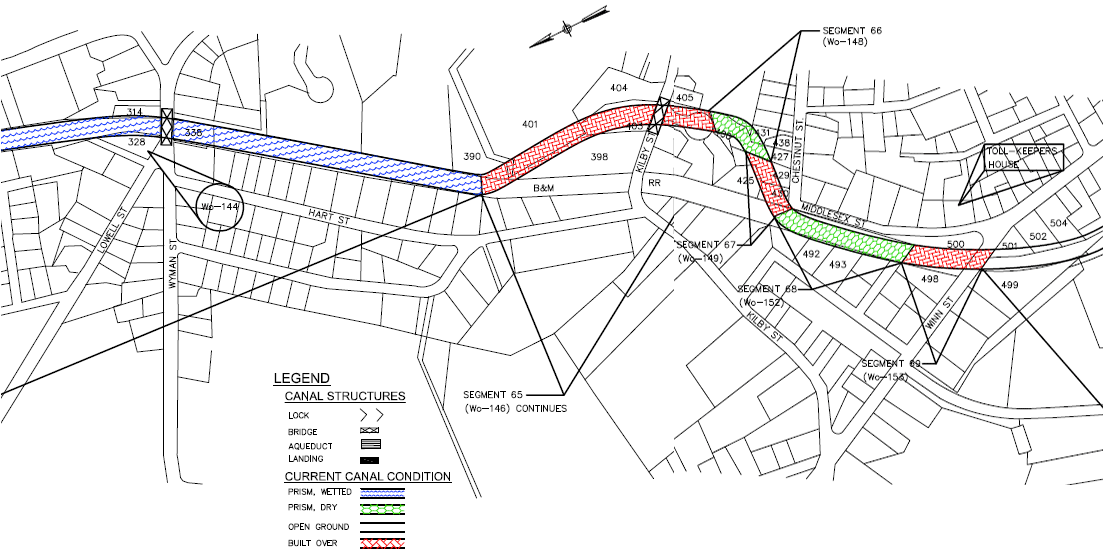
For comparison a map of the Mini-Ox Box in Woburn on the route of the Middlesex Canal
As we continued toward Kilby street we observed that we had to walk up and to the left via an apartment complex’s parking lot. We explained this as an almost second “Oxbow”, not as pronounced as that in Wilmington, and for much different reasons. Here, there was a deep cut, as it was totally rock to have to bore through. The canal’s regulations allowed the cut to be only 21½ ft. wide, with a very sharp turn, one of the most difficult areas for the boatmen to maneuver through. Wright’s bridge over the canal at this point was 17½ feet above the level of the canal water. Crossing the street today, all experienced the very deep seven step climb down to the level of the canal, for those who felt ambitious enough to try it.
When we hit the finish line at Winn St., we quickly pointed out that 5 Middlesex St., still standing, was the stop gate keeper’s house. There had been a basin at the site, and the stop gate keeper’s job was to let in water to the canal when needed. We pointed out that the prism of the end of our walk at this point was often thought of as the first fully formed canal prism one could define since the canal left Charlestown.
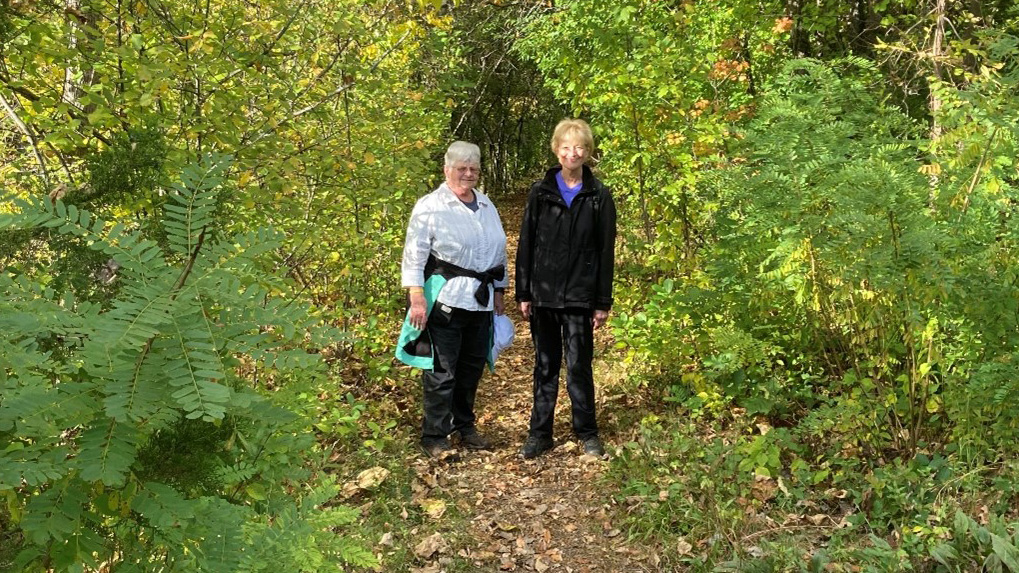
Joan Denton (left) and Jan Ellis bring up the rear returning to the Baldwin Mansion from School Street.
Only about a half dozen joined us for the extra walk from the Baldwin Mansion to School Street and back. However, all members of Cambridge and Oxford Alumni group were delighted to have been introduced to this oft hidden wonder that is the Middlesex Canal.
References Used:
Lawrence, Lewis M. The Middlesex Canal, 1942
VerPlanck, Burt Middlesex Canal Guide and Maps, 1996
October 29, 2023 Fall Meeting Minutes
by J Jeremiah Breen
At 1:15 o’clock, President J. Breen called the meeting to order with a progress report on the new museum. The Building Committee hopes to be able to hold the MCA Winter meeting in 2 Old Elm St. this winter and stop paying $1,700/month rent for 71 Faulkner St. There was no other business.
While the projector was being set up, Proprietor Doug Chandler gave an impromptu update on his April talk “Towpath to Bike Trail”, which is on hold pending activity in the Chelmsford Planning Board. A new project is a Lowell Middlesex Canal Heritage Park as authorized in the 1977 act establishing the MC Commission. This would include a multi-use trail between the end of the Bruce Freeman Rail Trail (BFRT) at Cross Point Tower (Rtes. 495&3) and the Merrimack River at Middlesex Village, and a quarter mile of watered canal which has survived the centuries beautifully. Also, re: the dam removal issue, see the MCA website for Towpath Topics of 40 years ago, August 1982, for a 7-page history of the 19th century legal conflict on the dam.
The chair adjourned the business portion of the meeting and introduced Howard Winkler, speaker on the topic, “Old Home Day” at the Middlesex Canal Association. When the projector broke, Howard soldiered on and regaled an audience of nineteen with history and notable members since the Association’s founding in 1962. Highlights included: Louis Eno – founder, Tom Dahill’s artwork, the Seaburg brothers’ posters and books, Dave Dettinger’s play about founding the canal, Roger Hagopian’s videos, Len Harmon’s canal boat and roadside plaques in each town, John and Shane Reardon’s starting the museum, Col. Hoxie’s maps, Tom Raphael getting it on the National Historic Register, and the many other docents and walk leaders. Notable contributing speakers were Len Harmon, chair of the MCC, Woburn commissioner, honorary director of the MCA, etc.; Tom Lincoln, secretary of the MCC and Medford commissioner; Neil Devins, MCA membership secretary and Wilmington commissioner; and Doug Chandler, Chelmsford commissioner. Karen Spence of Chelmsford contributed by opening Howard’s PowerPoint file in a 2013 computer. Howard closed with special mention of the original proprietors’ pleasure boat party, Edith Choate’s brownies and Betty Bigwood’s Virginia ham biscuits before adjourning to coffee, pizza, and pastry by Russ Silva and J Breen. The audience was invited to sign up for the briefing charts by email.
New Memorial Bench in Memory of James H. Winkler Installed on Deck of new MCA Museum
by Anne Winkler
A new bench on the deck of the new site of the MCA Museum remembers MCA proprietor James (Jim) Winkler (1963-2021). The gift is from his siblings, Anne Winkler (St. Louis, MO) and Mitchell Winkler (Houston, TX).
Jim (as he was known to MCA folks) was especially active in the MCA in the last few years of his life, but his connection to the Middlesex Canal goes back to his childhood and father Howard Winkler’s deep interest in the canal. Howard first learned about the canal in 1959 while traveling north along Rte. 128 to Rte. 38 to Avco in Wilmington, where he worked at the time. Howard joined as a Proprietor in 1967, served 29 years as Treasurer, and most recently serves as Corresponding Secretary. Jim’s introduction to the canal goes back to ca. 1969, when the whole Winkler family (Jim was 6) joined a group walk from Talbot Mill, across High Street, crossing Pond Street, and ending at Gray Street. The walk concluded with a spaghetti dinner sponsored by the Boy Scouts. Of the siblings, Jim’s older brother remembers it the best, since he was 11 at the time.
Fast forward to more recent times, Jim began attending Zoom MCA meetings (along with father Howard) and came up with the idea of using social media to expand interest in the canal and the MCA-sponsored walks. He proposed and set up a Meetup Group.
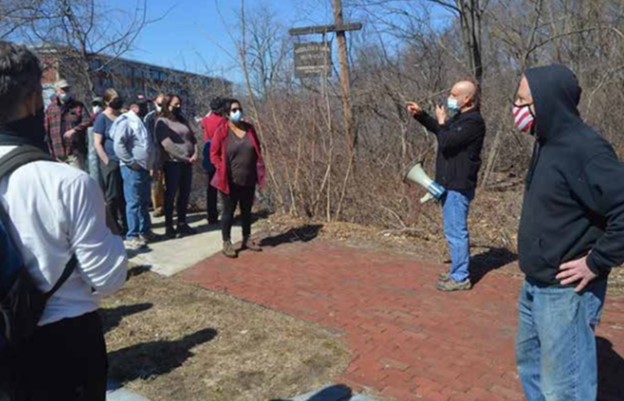
Jim Winkler leading an MCA sponsored canal walk. (from the May 2020 issue of Towpath Topics)
Jim served as a co-leader on two walks before his death in December 2021. He told the whole family how excited he was to see the turnout for the canal walk. Following one of the walks, he contributed an article to the May 2021 issue of Towpath Topics. He noted that the walk took the group through some neighborhood backyards that abutted the canal. Indicative of his sense of humor he wrote: “Fortunately, we did not see or hear from any of them!” (This comment makes sense based on the fact that he cut through yards on his way to high school and once got called out for doing so.) He was also—always —a humble guy. He also noted in his write-up, “The attendees had many questions: Some could be answered, and others could have used a canal historian.” For those who had a chance to interact with him, he had the most fun nature and was always smiling. His enthusiasm was infectious.
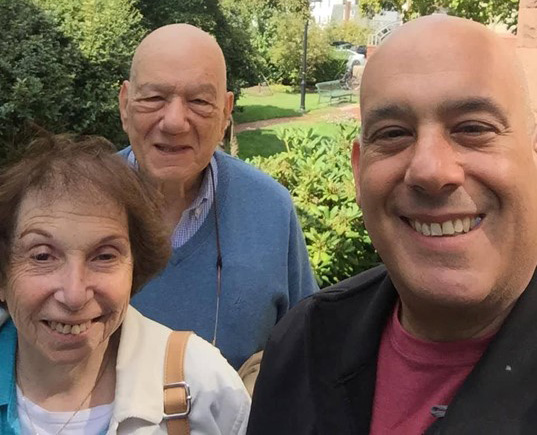
Howard and Lenore Winkler on the left with their son James Winkler
Without question, Jim would have continued to organize more Meetups and led more walks. He was enjoying this shared activity with his father. He likely would have gotten even more involved with the construction of the new MCA building, as he was a professional engineer, PE, with 35 plus years of experience managing complex engineering and construction projects.
The gift of the bench would not have been possible without the help of MCA President J. Breen. The entire Winkler family is hugely grateful. J secured Board approval, received the bench components from the shipping company, and assembled it.
The selection of the type of bench, font, and plaque text are all very intentional. Howard really liked the MCA’s memorial bench for Tom Raphael (located on Lowell Street); the same manufacturer makes this bench. Jim’s parents, Howard and Lenore, selected the site – the deck of the new MCA Museum – which the MCA Board approved. Jim and his parents had previously been there together when they all attended the event celebrating the new interpretive sign explaining the history of “The Summit Pond and Floating Towpath” on October 3, 2021. In this location, the bench is protected and has a lovely view. Jim’s sister Anne selected the font for the plaque – a simple font for an unpretentious guy. The plaque reads:
REMEMBERING OUR BROTHER
JAMES H WINKLER
WHO HAD A SMILE WHICH NEVER ENDED
ALWAYS READY TO ORGANIZE AND LEAD MCA WALKS
On January 5th, 2024, a small group gathered to celebrate the new bench. The group included Jim’s parents Howard and Lenore Winkler, his sister Anne, Anne’s partner Mark Ashley, MCA President J. Breen, and close friends Sue Smith, Crystal Sirois, and Andrew Fishman. The group took a variety of photos (and the photos of the bench included a photo of Jim.)
The Winkler family hopes that future MCA Museum visitors smile when they read the wording and then sit and enjoy the glorious view of Summit Pond and imagine the Floating Towpath of yesteryear.
Meets & Passes
by Bill Gerber
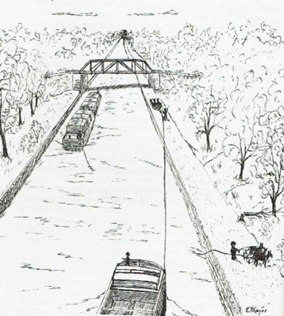 Why is it that the most ordinary things in life, that all people understand and often, routinely do, maybe several times a day, are seldom described in text? This is not a new or exclusive phenomenon; it seems that it has long been so. One example - from the early canal era - since all boats were towed from the same towpath, what were the rules and procedures to be followed when one boat had to ‘get by’ another; i.e. because they were traveling in opposite directions, or because one boat had a higher priority or perhaps was light and thus traveling faster than a loaded boat? How did they avoid tangling towlines? How did they avoid endangering each other?
Why is it that the most ordinary things in life, that all people understand and often, routinely do, maybe several times a day, are seldom described in text? This is not a new or exclusive phenomenon; it seems that it has long been so. One example - from the early canal era - since all boats were towed from the same towpath, what were the rules and procedures to be followed when one boat had to ‘get by’ another; i.e. because they were traveling in opposite directions, or because one boat had a higher priority or perhaps was light and thus traveling faster than a loaded boat? How did they avoid tangling towlines? How did they avoid endangering each other?
On the Middlesex Canal there were several relevant rules and procedures to effect safe and efficient travel. One rule was that packet boats, i.e., those which carried passengers and light freight (and which were often engaged in conducting the business of the canal company) and were allowed to travel at speeds up to about three and a half miles per hour, had priority over luggage boats, i.e., boats carrying freight of whatever variety there might be; both packets and luggage boats, which were allowed to travel at about two and a half miles per hour, had priority over slow-moving rafts of timber, and bands of rafts, which were only allowed to travel at up to one and a half miles per hour. — And a second rule was that - boats ascending the canal toward the summit level had priority over those descending from same.
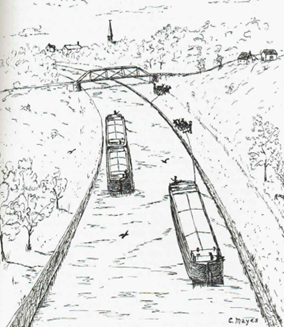 To execute a “meet”, i.e., when two boats were traveling in opposite directions, as shown in E. Myer’s drawing to the right, established policy was that the ‘lesser priority’ boat, i.e., the boat not having the right of way, would steer to the berm-side of the canal, at the same time it’s tow animal(s) would move to the outside of the towpath, and the towline between them would be slacked to the point where it would sink to the bottom of the canal and lay flat on the towpath. This would enable the boat having the right-of-way to pass between the ‘lesser’ boat and its tow animals, thereby floating over the sunken towline of the lesser boat, and for its tow animals to step over the slacked towline on the towpath. Note that neither boat’s towline was disconnected. And just as soon as the higher priority boat had passed, the lesser priority boat could resume its travel.
To execute a “meet”, i.e., when two boats were traveling in opposite directions, as shown in E. Myer’s drawing to the right, established policy was that the ‘lesser priority’ boat, i.e., the boat not having the right of way, would steer to the berm-side of the canal, at the same time it’s tow animal(s) would move to the outside of the towpath, and the towline between them would be slacked to the point where it would sink to the bottom of the canal and lay flat on the towpath. This would enable the boat having the right-of-way to pass between the ‘lesser’ boat and its tow animals, thereby floating over the sunken towline of the lesser boat, and for its tow animals to step over the slacked towline on the towpath. Note that neither boat’s towline was disconnected. And just as soon as the higher priority boat had passed, the lesser priority boat could resume its travel.
To execute a “pass”, where one boat, perhaps a lighter boat able to travel faster than a loaded one, as shown in E. Mayer’s drawing to the left, the procedure was almost identical. The slower boat would steer to the berm side of the canal, its tow animal(s) would move to the outside of the towpath, and the towline between them would be slacked to allow it to sink to the bottom of the canal and to lay flat on the towpath. The tow animal(s) of the faster boat would step over the towline, the faster boat would pass between the other boat and its tow animal(s) floating over the sunken towline, and as soon as accomplished, the slower boat would resume traveling.
These were often repeated maneuvers that everyone knew how and when to do it, and that could be accomplished very quickly such that not much time was lost by the lesser priority vessel in conducting it.
Another important rule to keep in mind: on most, if not all canals, the only time that a towline was allowed to be passed over the top of another boat was when a repair-boat was responding to a canal emergency and encountered another boat stopped/inert along the towpath side of the canal. This would have been an unusual/infrequent situation but undoubtedly happened from time to time.
The Canal Corporation’s First Female Shareholder: Elizabeth Guild
Brian JM Quinn1
Of the initial share subscribers in September 1793, only one woman, Elizabeth Quincy Guild, a widow, appears on the role of shareholders. Her four shares, purchased for $8, represent less than 1% of the outstanding shares. Her name on the list of investors in this high-risk project is appears anomalous, however, as a member of the Quincy family, she was not alone, with numerous cousins and in-laws also represented, including Ebenezer Storer (husband of her sister, Hannah), John Hancock, husband of her cousin, Dorothy Quincy Hancock and others. Elizabeth Guild was widowed in 1792, a year before she became a shareholder in the corporation. Unlike some wealthy widows and daughters of wealthy merchants whose names will later appear on shareholder lists, Elizabeth Guild’s story and her path towards shareholding in the Middlesex Canal Corporation appears to have been one of quiet desperation rather than opportunity.
Elizabeth was the only child of Josiah Quincy of Braintree (1710-1784) and Elizabeth Waldron (1722-1759), his second of three wives. Elizabeth had six siblings. Of these, two half-sisters: Hannah Quincy, and her younger sister, Ann Quincy would survive to adulthood and become confidants of Elizabeth.2 Elizabeth Quincy married Benjamin Guild in June 1784.3 Benjamin was a Harvard graduate and tutor, an itinerant preacher, and then, soon after his marriage to Elizabeth, he settled down and became a bookseller in Boston.4
His first bookstore was at No. 8 State Street.5 Financially, the bookstore was not very successful. In a letter from Mary Cranch to her sister Abigail Adams in July 1785, Mary recounted a recent visit by their cousin Elizabeth to Braintree and remarked about her misfortune:
Mrs. Guild has spent a week with her little Boy at Braintree. She is not well by any means, but looks chearful and behaves exceeding well under her dissapointment. She has sold all the Furniture of her best room and chamber and remov’d into that end of a House which Miss H. Otis liv’d in. What a reverse of Fortune in one year! Mr. Guild looks as if he was going into the Grave soon. His pale Face is paler than ever. His countenance excites pity from every eye.6
Their difficult situation during this time was apparently well-known within the family. John Quincy Adams recalled the couple in a 1785 letter to his sister Abigail:
… we found Mr. and Mrs. Guild, with [Elizabeth’s step-mother, Mrs. Anne Quincy]: they both look very much out of health. They have been very unfortunate; but I know of no persons in the same situation, that are so universally well spoken of. Mrs. Guild, has behaved upon the occasion, admirably, and what commonly greatly injures persons, in the opinion of the world seems to have been attended with effects directly contrary, with regard to her.7
John Adams recounts running into the couple in 1785 at the home of Ann Marsh Quincy, the third wife of Elizabeth’s father. “We found Mr. and Mrs. Guild there; they both appear in an ill state, of health; they have been unfortunate of late, but bear it with exemplary firmness.” 8 Benjamin ultimately closed shop at State Street and opened the Boston Book-Store at 59 Cornhill [now Government Center Plaza] in August 1786.9 The shop sold stationery, books, and “concave spectacles;” it also later expanded to include a private circulating library.10
Notwithstanding any difficulties they may have faced in Boston, the pair remained close to the rest of the Quincy clan. In 1789, Ann Quincy, Elizabeth’s youngest sister, sent a letter to Benjamin Guild seeking his views on the character of the Rev. Asa Packard of Marlborough as a potential match, “whether he is a good man, a good preacher, loving & beloved by his People.” 11 Apparently, Benjamin’s reference for Rev. Packard was positive as they were married eight months later in 1790.12 After Ann was married to Rev. Packard, Elizabeth would spend a good deal of time visiting Marlborough. Marlborough would become something of a refuge for her.
Tending to the work of the bookstore required Benjamin to travel to New York and Philadelphia to source books. Due to their mutual absences, there exists correspondence between Elizabeth and Benjamin. Sometimes the letters are written while Benjamin was traveling to New York or Philadelphia. Others are written to Elizabeth from Boston while she was visiting Marlborough or Braintree. These letters evidence an obviously affectionate relationship between the two. He calls her “your Ladyship” and laments their separation.13 Her letters back to him are written late in the evening, recount stories of their three children who miss him and declare her affection for him.14 The topics are mostly mundane, often including references to the poor state of their health. However, these letters also include gossip about people in their social circle and investment interests. In one such letter written in 1791 from Philadelphia, Benjamin describes for Elizabeth the intense interest by investors in the First Bank of the United States that was planned. The former preacher marveled at the wealth of acquaintances from Boston in Philadelphia to buy stock and described his plans to invest in the Bank’s stock:
… The subscriptions to the national Bank then open. I find it will fill up immediately and many gentlemen who have a large number of shares to subscribe are afraid they shall not procure the number they want as not more than 30 can be entered to any one name on the same day. It is my present intention to subscribe for ten shares (of 400 dollars each) and I must pay one quarter of the [ .. ] part on subscribing. I find the rage for the Bank is great in Boston. W[illiam] Payne. Templeman. Bond G. came here in waiting with large commissions. Payne told me he had order to subscribe for above 2000 shares and he supposes Massachusetts will gladly take 5000 if they can get them. Out neighbor up in the hills has ordered four hundred shares: an evidence to me that your [obscurities] is just; he has more money than he knows what to do with. What think you of our friend [Andrew] Craige subscribing 350 shares. This I am told he is coming on to do: and this is but a part of his wealth which I find is much more extensive than I had any idea of.15
In 1790, Benjamin and Elizabeth left their children with Elizabeth’s cousins, and traveled to Europe on a trip that was business for Benjamin and pleasure for Elizabeth, returning on the Charlotte, captained by Mungo MacKay in April 1791.16
A year and half later, in October 1792, Benjamin, long of poor health, would pass away at the age of forty-three.17 As was common for widows, Elizabeth took on the responsibility of being executor to Benjamin’s estate, with the help of George Minot as her attorney.18 The financial impact of becoming a widow was devastating on Elizabeth and her children. Benjamin’s partner, William Blake, took over the Boston Bookstore, but whatever the settlement Elizabeth may have received for Benjamin’s portion of that business, it was evidently not sufficient.19 By early November 1792, less than a month after her husband’s passing for the second time since 1785, Elizabeth was forced to sell most of their belongings from their Boston residence on Purchase Street, including:
genteel House-Furniture, viz. Neat Mahogany frame hair bottom Chairs, green Chairs with fluff bottoms, Mahogany dining card and tea Tables, Bereau, Mahogany four-post and common Bedsteads, Feather Beds, Carpets, Looking-Glasses, Glass China and Yellow Ware … Also, a good HORSE, 6 years old, … a few dozens MADEIRA, 7 years old.20
Elizabeth’s economic situation was obviously difficult, but she got by with help from family. After she sold the contents of their Boston home, Elizabeth moved to Marlborough to live with her sister, Ann (Quincy) Packard.
She also relied on help from her older sister, Hannah, and Hannah’s husband, Ebenezer Storer. In a letter to Ebenezer in December 1792, Elizabeth sought his assistance in selling “woolens” and other articles that presumably she had received from Benjamin’s partner, Blake, when the partnership was wrapped up. She hinted at previous financial assistance provided by Ebenezer and thanked him for sending her money:
… I am much obliged by your interest & kindness to my little Boys, heaven grant their conduct may be such as to secure the Patronage of friends – as to my self – but I will not tax you any more with so unpleasant a subject – Eliza remembers with pleasure all her Boston friends feeling no bitter regrets to damp her innocent mirth – all friends here join in best regards to you and your fire side with your Sister.
Elizabeth Guild
I do not forget I am in your debt my Dear Ebenezer and shall write you the next opportunity.
I received the $25 for which am much obliged.21
In November 1792, Elizabeth wrote to her first cousin once removed William Cranch and asked him to take up guardianship of her two sons, Benjamin, Jr. (8 years old) and Josiah (6 years old). William Cranch, son of Elizabeth’s cousin Mary Smith and Richard Cranch, was only twenty-three at the time, but he acceded to her request:
… Madam, you have friends older than I am, more experienced in the ways of the World & more capable of promoting the Interests of your Children – permit me to mention Mr. Storer – your venerable friend Dr. Howard, & your brother Packard – if, however, their avocations should be such to prevent them from accepting the trust … I presume I need not assure you, that you may command my best abilities & Exertions to promote the Interest, Education, & Happiness of your Children.22
The boys subsequently went to Braintree and were raised for some years by William and his mother, Mary. Mary sent frequent and regular reports to Elizabeth who moved to Marlborough to live with her sister, Ann. Sometime in 1793 and still in a desperate position, Elizabeth wrote to Mrs. Mehitabel Higginson of Salem and asked her – due to her “misfortune” – to take her daughter, Elizabeth Ann (4 years old) and assume responsibility for her:
… I am driven by circumstances into the most public & irksome situation, the attention I have hitherto paid to [Eliza Ann], I must know relinquish to some friend.
Will you Madam accept the Charge? And in the first place if you can teach her that necessary dependence upon herself without which she must forever be the slave of accident.23
There is no evidence that Elizabeth Ann was ever sent to live in Salem and presumably little Eliza Ann remained with her mother. In a February 1793 letter to Abigail Adams Smith, Abigail Adams described Elizabeth’s situation:
your Friend mrs Guile [sic] is disconsolate. she has retired with her daughter to marlbourough taken a chamber in a House next to her sister Packard, where she refuses to be comforted, will not see her acquaintance or mix at all in Society. her two sons She has placed with mrs Cranch who has a young Clergyman as a preceptor to them and Cornelias.24
Elizabeth’s correspondence with various business associates of deceased husband during that time reveals that, as executor, she was not particularly successful in collecting debts from the various persons who owed money to Benjamin, with many of them setting their debts to Benjamin’s estate by setting them off against their own claims against the estate or promising to make good on them in the future. For example, in February 1793, Daniel Parker, business associate of Benjamin’s in London, responded to a letter from Elizabeth written almost immediately after his death in which she appears to have been primarily concerned with monies possible owed to Benjamin. Unfortunately for her, it appears that Benjamin owed money to Parker rather than the other way around:
I have felt great distress on the melancholy circumstances which occasioned your Letter. I sincerely sympathize with your under so great a loss, & hope you will find that consolation & support which your bereaved situation so much requires. As I was not privy to the transactions of Guild & Co. it is impossible for me to say what may be the state of their accounts, but from the large sums that I have paid for debts contracted by him, I have always believed that the balance of those amounts would be much in my favor, & Mr. Guild never informed me that he supposed any balance was due from me either to Guild & Co. or to him.25
Against this scene of economic and personal distress, Elizabeth Guild’s name made a surprising appearance on the subscriber list for the Middlesex Canal in September 1793. That a widow experiencing financial distress would subscribe for four shares of stock in a highly risky investment is at the very least unusual. As it happens, her appearance was less the act of a woman of means making a calculated investment than it was an act of charity intended to assist a relative down on her luck. Elizabeth Guild’s shares were purchased for her by Ebenezer Storer, the husband of her older sister Hannah Storer.

Figure 1: Initial Subscription Shareholder List, Middlesex Canal Corporation, 1793 26
Perhaps Hannah and her husband believed that by purchasing four shares for her sister, Elizabeth would benefit from a stream of dividends sufficient to provide her with an income. If that was the reasoning, it was a mistake. The corporation would not pay its first dividends until 1819 and for the first ten years shareholders, including Elizabeth, were subject to regular capital calls. Notwithstanding her poverty, the Treasurer’s Journal confirms that Elizabeth met the capital calls, or had them paid for her.27
Elizabeth remained in debt to her family. By July 1795, her nephew, Josiah Quincy III (1772-1864), apparently had enough and asked his aunt to repay her debts to him:
I left it yesterday optional with you to obtain the money from another friends or remain indebted to me. Upon further reflection, I think I shall probably want it before [another] 12 months. And if it be perfectly equal to your feelings and interest I prefer you should procure it from that other friends.28
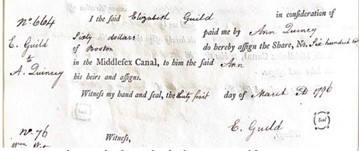
Figure 2: Stock Transfer from Elizabeth Quincy Guild to Ann Quincy Packard, 1796 29
On March 31, 1796, Elizabeth Guild sold two of her shares to her sister, Ann Packard, for sixty dollars each. This income of one hundred twenty dollars was no doubt welcome and it relieved Elizabeth of the obligation to meet the capital calls for those two shares. The sale may have also made it possible for her to repay some of the debt owed to nephew Josiah.
At the time of this transaction, Ann was a married woman, a femme covert. As a married woman, she did not have the capacity to enter into contract to purchase shares. Nevertheless, she did. She also appeared to purchase these shares as personal property as “Ann Quincy” and not “Ann Packard.” Ann Quincy remained a shareholder of the company, in her own name, meeting capital calls as they came due. “Ann Quincy” subsequently appeared on lists of shareholders until 1817 when she transferred one share to her husband, Asa Packard, and the other to her nephew and Elizabeth Guild’s son, Benjamin Guild, Jr.30 While Ann’s purchase of shares from Elizabeth could be characterized, like Elizabeth’s initial subscription, as a charitable contribution to Elizabeth’s welfare, it was nevertheless recorded in the corporation’s transfer book as a bona fide transfer. As such, it is perhaps the earliest evidence of a stock transaction between two women, one of them married, in the United States.31
Notwithstanding Elizabeth’s distressed economic position in the years following the death of her husband and the lack of obvious economic benefit associated with being a shareholder of the Middlesex Canal Corporation, she remained a shareholder, holding on to the two remaining shares purchased for her by Ebenezer Storer. Elizabeth’s two shares were subject to $1,030 of capital calls from 1797 through 1806. Throughout all that time, Elizabeth, or a family member, met those obligations and she remained a shareholder in good standing until the first dividends were paid in 1819.32
Elizabeth Guild ultimately settled in Newton, Massachusetts where she passed away in 1825. Elizabeth’s fortunes and those of her three children, Benjamin Jnr., Josiah Quincy and Elizabeth Ann, seem to have turned at some point. In her will, Elizabeth bequeathed $8,333 to her daughter Elizabeth Ann Guild.33 Elizabeth’s two shares in the Canal Corporation were transferred to her daughter, Elizabeth Ann Guild.34
Four years after Elizabeth Guild’s passing, Elizabeth Ann Guild had a trust in her name that included thirteen Middlesex Canal shares.35 Most of these shares had been acquired from William Payne via a commercial purchase.36 George Jackson (Elizabeth Ann’s cousin) & James Savage were named “trustees to Elizabeth Guild.” In 1835, George Jackson was replaced as a trustee by Josiah Quincy, Jnr. (Elizabeth Ann’s nephew).37 At that point, Elizabeth Ann Guild was thirty years old; there is no record of Elizabeth Ann ever marrying, so a trust would not have been necessary for her to own shares as separate property as she was not a femme covert. The trust, however, might reflect reasonable planning in anticipation of a potential match, or simple paternalism by male members of her family.
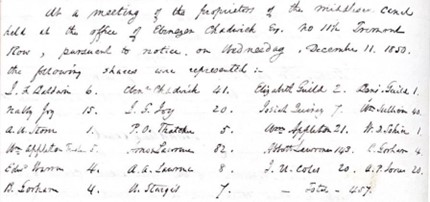
Figure 3: Middlesex Canal Corporation: Shareholder Meeting, December 11, 1850 38
Although destitute at the time his mother sent him to live with relatives, Benjamin Jr. grew to become a lawyer with offices in Barrister’s Hall in New Court House Square by 1812.39 In 1814, Benjamin Guild, Jnr. had risen to become a director of the Middlesex Canal Corporation.40 At some point, Benjamin was named president of the Middlesex Canal and served in that position until 1830.41 Benjamin would rejoin the board of directors in 1830 and remain a director, along with his cousin, Charles Francis Adams, until 1837.42 The original act of charity that saw his mother receive stock ultimately led to a successful vocation for Benjamin Jnr.
As a coda to the story of Elizabeth Guild, a review of the minutes of the proprietor’s meeting in 1850, reveals that her daughter, Elizabeth Ann and her son, Benjamin, were both present at the meeting at the annual meeting of the shareholders. Two other women, Abigail ‘Nabby’ Joy and Anna Powell (“A.P.”) Jones, were also present at this meeting. Nabby Joy was recorded as owning 15 shares; Anna Jones was recorded as owning 20 shares.43 The main business of the 1850 meeting was to set the stage for the eventual shutdown of the canal as it faced increasing competition from the Boston-Lowell Railroad.44 There is no record of either any of the women shareholders present at that meeting speaking at this meeting, though votes were taken presumably they exercised their votes.
1 Professor of Law, Boston College Law School. [Draft as of Sept 22, 2023]
2 Josiah Quincy Col. (1710-1784), Online publication (Provo, UT) Ancestry.com. Original data: Family Tree files submitted by Ancestry members.
3 Marriage Announcement, Salem Gazette (1784), June 22, 1784, (online NewsBank).
4 Leah Orr, Selling Books in Eighteenth-Century Boston: The Daybook of Benjamin Guild, 95 THE NEW ENGLAND QUARTERLY 681, 683 (2022).
5 Massachusetts Centinel (1785) ‘Advertisement’, III(12), 30 Apr, p. [3], (online NewsBank).
6 Elizabeth Guild would later entrust her two sons to be raised for a time by Mary Cranch. Letter from Mary Smith Cranch to Abigail Adams, July 19, 1785, Adams Family Correspondence, Vol. 6, Adams Papers, Digital Edition, Massachusetts Historical Society.
7 Letter from John Quincy Adams to Abigail Adams 2d, September 8, 1785, Adams Family Correspondence, Vol. 6, Adams Papers, Digital Edition, Massachusetts Historical Society.
8 “18th.,” Founders Online, National Archives, https://founders.archives.gov/documents/Adams/03-01-02-0007-0011-0018. [Original source: The Adams Papers, Diary of John Quincy Adams, vol. 1, November 1779 - March 1786, ed. Robert J. Taylor and Marc Friedlaender. Cambridge, MA: Harvard University Press, 1981, p. 326.]
9 Massachusetts Centinel (1786) ‘Advertisement’, V(43), 16 Aug, p. [4], (online NewsBank).
10 Leah Orr, Selling Books in Eighteenth-Century Boston: The Daybook of Benjamin Guild, 95 THE NEW ENGLAND QUARTERLY 681, 683 (2022); Independent Chronicle (1787) ‘Advertisement’, XIX(987), 27 Sep, p. [4], (online NewsBank)(advertising books and “concave spectacles.”); Massachusetts Centinel (1789) ‘Advertisement’, X(40), 31 Jan, p. 162, (online NewsBank) (advertising books and the “circulating library”).
11 Letter from Ann Quincy to Benjamin Guild, October 20, 1789, Guild Family and Eliot Family Papers, Houghton Library, Harvard University, MS Am 2922.
12 Columbian Centinel (1790) ‘Matrimony Notice’, XIII(40), 31 Jul, p. 167, (online NewsBank).
13 Letter from Benjamin Guild to Elizabeth Guild, July 1, 1791, Guild Family and Eliot Family Papers, Houghton Library, Harvard University, MS Am 2922.
14 Guild Family and Eliot Family Papers, Houghton Library, Harvard University, MS Am 2922.
15 Letter from Benjamin Guild to Elizabeth Guild, July 1, 1791, Guild Family and Eliot Family Papers, Houghton Library, Harvard University, MS Am 2922.
16 Ship News, Cumberland Gazette (1791), April 18, 1791, (online NewsBank) Capt. Mungo MacKay was a well- known merchant captain and, along with his wife Ruth, an investor in the Middlesex Canal Corporation.
17 Columbian Centinel (1792) ‘Mortuary Notice’, XVIII(11), 17 Oct, p. [3], (online NewsBank); Mortuary Notice, American Apollo (1792), October 19, 1792 (online Newsbank).
18 Guild Family and Eliot Family Papers, Houghton Library, Harvard University, MS Am 2922; Joan R. Gundersen and Gwen Victor Gampel, Married Women’s Legal Status in Eighteenth-Century New York and Virginia, 39 THE WILLIAM AND MARY QUARTERLY 114, 119 (1982) (observing it was common practice for a widow to become administratrix of his husband’s estate).
19 Boston Bookstore Announcement, American Apollo (1792), October 26, 1792 (online Newsbank). William Blake ran the bookstore on his own until June 1796 when it was taken over by William Pelham. Columbian Centinel (1796) ‘Advertisement’, XXV(32), 25 Jun, p. [4], (online NewsBank).
20 Estate Sale, The Boston Gazette (1792), October 29, 1792 (online Newsbank).
21 Letter from Elizabeth Guild to Ebenezer Storer, December 6, 1792, Guild Family and Eliot Family Papers, Houghton Library, Harvard University, MS Am 2922.
22 Letter from William Cranch to Elizabeth Guild, December 8, 1792, Guild Family and Eliot Family Papers, Houghton Library, Harvard University, MS Am 2922.
23 Letter from Elizabeth Guild to Mehitabel Higginson, 1793, Guild Family and Eliot Family Papers, Houghton Library, Harvard University, MS Am 2922. For many years, Mrs. Mehitabel Higginson ran a well-known “school for young ladies” in Salem for many years. New England Historical and Genealogical Register for 1872 at 431, available at https://www.google.com/books/edition/The_New_England_Historical_Genealogical/ubs-AAAAYAAJ?hl=en&gbpv=1&dq.
24 Letter from Abigail Adams to Abigail Adams Smith, February 10, 1793, Adams Family Correspondence, vol. 9, Adams Papers, Massachusetts Historical Society. (here)
25 Letter from Daniel Parker to Elizabeth Guild, February 24, 1793, Guild Family and Eliot Family Papers, Houghton Library, Harvard University, MS Am 2922.
26 1793 Subscriber List, Middlesex Canal Corporation Records (B1, F10) (“for Elizabeth Guild by letter from Ebenezer Storer Esq[…] 8 dollars by hand of Mr. Atkinson } 4 shares,”).
27 Treasurer’s Journal, Middlesex Canal Corporation Records, Book J & Book P.
28 Letter from Josiah Quincy to Elizabeth Guild, July 13, 1795, Guild Family and Eliot Family Papers, Houghton Library, Harvard University, MS Am 2922.
29 Share Transfer Book, Middlesex Canal Corporation Records, Book A.
30 Share Transfer Book, Middlesex Canal Corporation Records, Book B.
31 Although Elizabeth Quincy Guild was a widow, Ann Quincy Packard was a married woman at this time of this transaction, having been married to Rev. Asa Packard in 1790. See Abigail Adams to Lucy Cranch, FN 6, 5 January 1785,” Founders Online, National Archives, https://founders.archives.gov/documents/Adams/04-06-02-0016.
32 Treasurer’s Journal, Middlesex Canal Corporation Records [ .. ].
33 Will of Elizabeth Guild, October 7, 1825, No. 27753, Ancestry.com. Massachusetts, U.S., Wills and Probate Records, 1635-1991 [database on-line]. Lehi, UT, USA: Ancestry.com Operations, Inc., 2015. Original data: Massachusetts County, District and Probate Courts.
34 Share Transfer Book, Middlesex Canal Corporation Records, Book B.
35 Share Transfer Book, Middlesex Canal Corporation Records, Book A.
36 Share Transfer Book, Middlesex Canal Corporation Records, Book B.
37 Certificate No. 19, Elizabeth Ann Guild, Middlesex Canal Corporation Records, (B3, F29).
38 Minutes of Proprietors’ Meetings, 1830-1854, Middlesex Canal Corporation Records, Book K.
39 Boston Commercial Gazette (1812) ‘Advertisement’, 36(48), 8 Jun, p. [3], (online NewsBank).
40 Director Lists. http://www.middlesexcanal.org/docs/mogan.htm.
41 Id.
42 Id. Charles Francis Adams, son of John Quincy Adams, was indifferent about his position as director and something of a dilletante, more interested reading philosophy than the business of commerce. After being re-elected to the board of the Canal on February 3, 1831 he commented: “I went however to keep my place at the Board, which I thought it likely I might lose without. I care nothing about it, excepting that as representative of my father’s Stock, I can see how his Interest stands and keep him informed of it.” See Diary of Charles Francis Adams, Vol. 3, February 3, 1831, Adams Papers Digital Edition, Massachusetts Historical Society.
43 Anne P. Jones was a daughter of John Coffin Jones. The meeting was held at the office of Ebenezer Chadwick (41 shares). In 1844, Jones had given her proxy to Chadwick. Chadwick was the husband of Elizabeth Coffin, and he acquired at least some of his shares via his wife. Also present were Isaac Underhill Coles (20 shares), the husband of Martha Ellery Jones, as well as Benjamin Gorham (4 shares), the husband of Margaret Champlin Jones. Both Coles and Gorham acquired their shares by way of their wives. Nabby Joy was the niece of Benjamin Joy, a former Canal Corporation director. Benjamin Joy was married to Hannah Barrell, daughter of Joseph Barrell, an early shareholder in the Canal Corporation who bought his shares from Dorothy Hancock following the death of John Hancock.
44 By 1830 it was becoming obvious to Charles Francis Adams, a director of the Corporation, that the development of the Boston–Lowell Railroad would threaten the commercial viability of the canal. Diary of Charles Francis Adams, vol. 3, March 12, 1830, Adams Papers Digital Edition, Massachusetts Historical Society. The directors of the corporation gave notice in 1851 of their intent to close the canal and began to sell off assets. Salem Register (1851) ‘Closing An Old Thoroughfare’, 4 Sep, p. 2, (online NewsBank).
Editors’ Note re: Fanny Searle
The route of the Middlesex Canal skirted Horn Pond in Woburn. The pond soon became an attractive recreational spot for people who resided in the environs of Boston. It provided a country escape from the crowded, noisy urban lifestyle. The proprietors of the canal recognized this and invested in the area. Excerpts from an 1817 letter from Miss Fanny Searle to Mrs. Margaret Curzon first appeared in the October 1971 issue of Towpath Topics. It is reprinted here for the enjoyment of our readers. The entire letter first appeared in Volume VII of the Colonial Society of Massachusetts publication under the Date April 1901. Mr. Henry H. Edes, who was responsible for bringing the letter to the attention of the organization, wrote that Fanny was a member of a large gathering “of what was the best in the Society of Old Boston Town.” In the summer of 1817, the august group began the 9-mile journey along the Canal to Horn Pond. Among the party was Daniel Webster and his wife. He had recently concluded two terms in the House of Representatives and had moved from New Hampshire to Boston. Frances “Fanny” Searle (1783-1851) was born in Essex County, Massachusetts. She was the daughter of George Searle (1751-1796) and Mary Russell Atkins (1753-1836) of Newburyport, MA. Her father was a painter by trade. She was a member of a large family. One record indicates she had nine siblings, four who did not survive to maturity. The recipient of her July 20th letter was her sister Margaret (Searle) Curzon (1787-1877), who, at the time, was traveling to Cuba.
In 1817, Fanny was the governess in the family of Richard Sullivan of Brookline, and had for her charge, the young daughters of the house. She was invited to join the excursion to Horn Pond by his wife. Richard was a lawyer, politician and the brother of John Langdon Sullivan, who was for a time superintendent of the Middlesex Canal Company. The invitation was extended to her brother George Searle (1788-1858) as well, but he declined. He was of the opinion that it was too warm for such an adventure. At the time of her death Fanny resided with George’s family in Brookline. It appears that she never married.
It is clear from the letter that Fanny enjoyed the excursion to Horn Pond and meeting the renowned Daniel Webster. Sit back and enjoy the trip along the Canal from Charlestown and the wonder of the Horn Pond experienced through Fanny’s words!
MISS FANNY SEARLE TO MRS. MARGARET CURZON.
Brookline, July 20th (1817)
We entered the boat in Charlestown and set off at ½ past nine; the water gave coolness to the air and the boat being covered, gave shelter from the sun, and the party was too large to have any stiffness; indeed, there was the utmost ease and good humor without sadness through the day. The shores of the Canal for most of the distance are beautiful. We proceeded at the rate of 3 miles an hour, drawn by 2 horses, to the most romantic spot (about 9 miles from Boston) that I ever beheld; you have not, I believe, seen, though I dare say you have had a description of, this spot. Mr. J. L. Sullivan has erected a little building on the banks of a lake most beautifully surrounded by woods and occasional openings into a fertile country. The lake is about twice the size of Jamaica Pond or larger, and has a small wood-covered island1 in the centre. On this Island a bank of music was placed which began playing as soon as we landed. It seemed a scene of enchantment. Cousin Kate who was by my side seemed too much affected to speak. Kate happened to be at Mrs. Quincy’s on a visit of a week and went as one of her family. Olivia Buckminister was with us, her sisters declined. I was truly sorry not to have Eliza there. We had Mr. Webster;2 Savage,3 Callender,4 Tudor;5 H. Gray;6 P. Mason;7 Russell Sullivan8 and two of his College friends, – Emerson9 and Sam’ May,10 with whom I was very much pleased. Besides the Mr. Sullivans, (were) Mr. Quincy11 and Mr. Amory;12 making in all a pretty large number. Having so many wits of the party, there was no lack of bon mots. The gentlemen played off upon each other, to our no small amusement, most of the time. When their spirits flagged at all we had the resource of music. Five instruments, horns, flutes and a violin were extremely well performed on at intervals thro’ the day, and at times we had vocal music from Mrs. Quincy, Mr. Callender and Mrs. W. Sullivan, and occasionally Mr. Webster and young May, who discovered, I thought, true, modest assurance with very good sense. Do you know him?
The ascent of the Canal was altogether new to me and very interesting; we passed 3 or 4 locks, and it was all the pleasanter for having so many children to whom it was likewise a novelty. After we landed and had ranged about a little, the children danced on the green under a tent or awning and we had seats around them. I never saw more pretty or happy faces than the little group presented. After two or three hours passed in looking about us and admiring the various beauties of the place, we entered the building I spoke of in which we were quite hungry enough to relish. Two long tables accommodated the young and old, and there was just room for benches on each side. This was the only time I felt the heat, which was greater on that day (the 18th July), than it has been any other this season. We ladies were therefore glad to leave the gentlemen very soon and dispersed where best it pleased us for an hour. We again collected and re-entered the boat; tables were placed the whole length of it on which were arranged fruit, wine, ice and glasses, and we had very good room on each side of them. Mr. Sullivan made this arrangement thinking it would delay us too long, if we had the desert in the pavilion, for Mrs. Quincy, who had so great a distance to go; however, it seemed to be the general opinion we had set out too soon, therefore we landed again at another delightful spot13 about 2 miles farther down, where we stopped an hour. It was a fine grove, sloping down to another large pond;14 beyond which was seen in the distance the little village and spire of Menotomy,15 – a pretty termination of the view. This was as pleasant an hour as any in the day, and here it was (that) I was particularly struck with May. We were standing on the edge of the pond and observed some pond lilies a little distance in the water, too far to be reached however without going into the water. Some lady expressed a wish to have one. “Is there no gentleman spirited enough to come forward and get them?” said Mr. Webster, “is no one gallant enough! – strange! ‘t is very strange!” May stood it so far and then darted forward urged on by Mr. W., who said he was glad the days of chivalry were not over, – “very glad to see you have so much courage, Mr. May.” “It would have required more courage not to have done if after the challenge I received,” said May; “I claim no merit, Sir.” “A little farther, Sir,” said Mr. Webster, “there is another on your right; one on the other side,” &c. May went on till he was up to his middle, and I besought Mr. W. not to urge him farther. “Oh,” said he, “it does not hurt a young man to wet his feet; I would have gone myself if it were not for the ladies.” May presently came back with his hands full of flowers, which he gave to Mr. Webster, and from him the ladies near received each one. Mr. S(ullivan) came up just then and asked May what had induced him to it. “Mr. Webster’s eloquence, Sir,” said he. “It never procured me a lily before,” said the Orator. “Though it has many laurels,” replied May. Mr. W. Bowed, and thus ended this little affair, which I thought your interest in the Col. might lead you to listen to with pleasure.
I have not done justice to Mr. Webster’s words and his look and manner, (which) if you have not seen, no words of mine can paint to you. It always delights me to see him, and I never was so much charmed as this day. To all (the) wit and power of mind of all the other gentlemen he super-adds a tenderness and unaffected feeling that is seldom seen is his sex and especially at his time of life and in his pursuits. I only wish I could see as much of him as Eliza Buckminster does and feel, as she does, that he is her friend. I have the pleasure of his recognizing me whenever I meet him and generally have a little of his conversation. This is quite a digression from my story. Well, we entered the boat again and gently pursued our course a few miles farther when we again stopped near a house16 where coffee had been prepared for us; we did not, however, enter the house, but the coffee and necessary apparatus were deposited in the boat. The children then had another cotillion while the boat was descending one of the locks, which was not so pleasant as the ascent. We then walked a short distance on the shore, got into the boat again, took coffee, listened again to sweet strains, and saw the sun descend and the moon rise in a sky beautifully bedecked by light clouds, and reached our place of debarkation17 just after the last tints of daylight had faded.
Notes:
1 Horn Pond.
2 Daniel Webster.
3 James Savage, long the President of the Massachusetts Historical Society.
4 John Callender, Clerk of the Supreme Judicial Court. See Loring’s Hundred Boston Orators, pp. 257, 258.
5 William Tudor, the founder and first editor of the North American Review, and a founder of the Boston Athenaeum.
6 Horace Gray.
7 William Powell Mason, law-partner of the Hon. William Sullivan, and later Reporter of the United States Circuit Court.
8 Rev. Thomas Russell Sullivan, son of Dr. John Langdon Sullivan, was settled over the Unitarian Church at Keene, N.H.
9 George Barrell Emerson.
10 Rev. Samuel Joseph May. He was a son of Col. Joseph May, for more than thirty years a Warden of King’s Chapel.
11 Josiah Quincy.
12 Jonathan Amory.
13 In later years known as Bacon’s Grove, near the present Wedgemere station on the old Boston and Lowell Railroad. Near this grove, in 1819, was a mill owned by John Langdon Sullivan.
14 Upper Mystic Pond.
15 West Cambridge, now Arlington.
16 This was the tavern of the Medford River lock, which stood on the northerly corner of Boston Avenue and Arlington Street, West Medford.
17 On the shore of the Mill Pond in Charlestown, near the present Sullivan Square, which was named in honor of Governor Sullivan
MISCELLANY
Back Issues - More than 50 years of back issues of Towpath Topics, together with an index to the content of all issues, are also available from our website http://middlesexcanal.org/towpath. These are an excellent resource for anyone who wishes to learn more about the canal and should be particularly useful for historic researchers.
Estate Planning - To those of you who are making your final arrangements, please remember the Middlesex Canal Association. Your help is vital to our future. Thank you for considering us.
Membership and Dues – There are two categories of membership: Proprietor (voting) and Member (non-voting). Annual dues for “Proprietor” are $25 and for “Member” just $15. Additional contributions are always welcome and gratefully accepted. If interested in becoming a “Proprietor” or a “Member” of the MCA, please mail membership checks to Neil Devins, 28 Burlington Avenue, Wilmington, MA 01887.
Middlesex Canal Association Officers and Directors: http://www.middlesexcanal.org/directors.htm
Museum & Reardon Room Rental - The facility is available at very reasonable rates for private affairs, and for non-profit organizations to hold meetings. The conference room holds up to 60 people and includes access to a kitchen and restrooms. For details and additional information please contact the museum at 978-670-2740.
Museum Shop - Looking for that perfect gift for a Middlesex Canal aficionado? Don’t forget to check out the inventory of canal related books, maps, and other items of general interest available at the museum shop. The store is open weekends from noon to 4:00pm except during holidays.
Web Site – The URL for the Middlesex Canal Association’s web site is www.middlesexcanal.org. Our webmaster, Robert Winters, keeps the site up to date. Events, articles and other information will sometimes appear there before it can get to you through Towpath Topics. Please check the site from time to time for new entries.
The first issue of the Middlesex Canal Association newsletter was published in October, 1963.
Originally named “Canal News”, the first issue featured a contest to name the newsletter. A year later, the newsletter was renamed “Towpath Topics.”
Towpath Topics is edited and published by Debra Fox, Alec Ingraham, and Robert Winters.
Corrections, contributions and ideas for future issues are always welcome.
